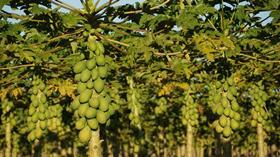
The Brazilian government has launched an ambitious programme to stimulate the country’s fruit exports and exploit new opportunities in high value markets.
The Brazilian Fruit Development Plan (BFDP) will look at research and development, production systems, plant health, infrastructure and logistics, marketing, credit and risk mitigation and several other key areas in a bid to unlock the country’s export potential.
The plan, which was due to be unveiled in January, is the result of a joint initiative from the Agriculture Ministry and the country’s leading producers of fresh and processed fruits and is being overseen by Eumar Novacki, executive secretary at the ministry, and Luiz Barcelos, president of producer and exporter association Abrafrutas.
“The plan will provide the political framework and initial analysis from which the industry can go on to develop projects on a case-by-case basis,’ explained Ricardo da Cunha Cavalcanti Júnior, advisor to the executive secretariat of the Ministry of Agriculture. “The first step involves setting up a management committee, then it comes down to prioritising specific actions for each product category and geographical region.”
Da Cunha pointed out that Brazil has huge potential to develop a wide range of products in different parts of the country. “The north, for example, is known for its production of acai berries but there is also an opportunity to develop other, lesser-know Amazonian fruits such as cupuaçu, murici and acerola, while areas such as the São Francisco and Açcu Valleys have considerable potential when it comes to the production and export of mangoes, grapes, melons, as well as wide range of tropical fruits like guava, soursop and cashew.
Indeed, while Brazil is a global leader in agri-exports, it punches well below its weight when it comes to fruit and Barcelos acknowledges that it has a long way to go to improve its competitiveness.
“Brazil is the third biggest fruit producer in the world but ranks 23rd in terms of exports,” he told Fruitnet. “Nevertheless, exports are growing – the latest data shows a rise of 11 per cent for the ten months to October 2017.”
The figures reflect a renewed marketing push since the creation of Abrafrutas in 2014 and subsequent launch of the Frutas do Brasil brand by Abrafrutas and trade promotion agency Apex-Brasil a year later. The two bodies were due to renew their agreement for the next two years in December after which Barcelos says efforts to position the brand internationally would begin again in earnest.
“We’re putting together a number of actions including point-of-sale promotions in supermarkets and specialist fruit stores highlighting the tropical origins of Brazilian fruit,” he said.
“The focus will be on educating consumers about the quality and sustainability of fruit grown in a tropical country where the sun is our biggest ally.”
Meanwhile, the government is looking to attract more foreign investment to fund investment in ports and roads after identifying inadequate infrastructure as one of the biggest obstacles to agricultural expansion as part of a more open trade policy that is also seeking wider market access for Brazilian products.
When it comes to opening new markets and negotiating trade agreements Brazil lags well behind South American competitors like Chile and Peru, and successes have been frustratingly slow to arrive.
“In Asia we can now ship melons and avocados to Japan, as well as table grapes to South Korea, but there is so much more to do,” Barcelos acknowledges. “China in particular is a priority. We are getting a lot of help from the agriculture ministry but these things take time.”
Progress on free trade agreements has been even slower, and Barcelos admitted this is hampering trade.
“We are in the process of negotiating a deal with the European Union, but its scope is so wide that it is proving challenging. Nevertheless, we hope to have a deal in place shortly as this would reduce the tariffs on Brazilian fruit by an average of 10 per cent.”
Meanwhile, Brazil will once again increase its presence at this year’s Fruit Logistica. It has extended its pavilion by 100m2 and increased the number of companies that will exhibit at the fair, which at the time of going to press stood at 18.



